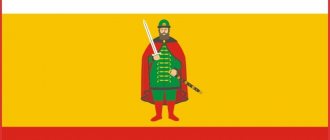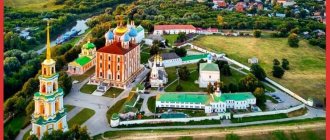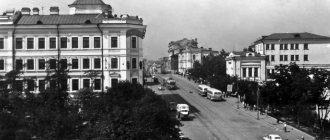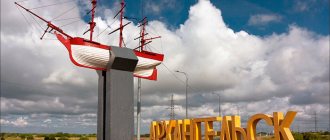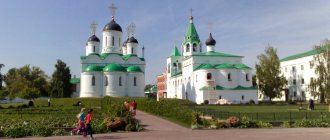General information about the Ryazan region
The Ryazan region is one of 85 constituent entities of the Russian Federation, located in the center of the European part of Russia. Geographically, the region is located in the depression of two vast elevations - Central Russian and Volga.
The Ryazan region covers an area of 39,600 km². Here are the 3 largest rivers of Russia: Don, Oka and Tsna. They have a wide floodplain and overflow during the spring flood. The Oka divides the region into:
- The northern part is covered with dense thickets of coniferous and deciduous trees. The famous Meshchera National Park and the Prioksko-Terrasny Biosphere Reserve are located here.
- The southern part, a large area of which is occupied by forest-steppe.
The territory of the Ryazan region has many mineral deposits: limestone, marl, clay, sand, iron ore, coal, etc. Cement limestone, glass and quartz sand are mainly valued. Peat of excellent quality, which lies in a vast thick layer, is called the most important and most valuable.
Approximately 1/3 of the entire region is occupied by broad-leaved, coniferous and mixed forests. Climatic conditions: moderate continental. The air temperature here varies depending on the season from -20°C to +30°C.
During the year, 500 mm of precipitation is recorded, of which up to 35% is in the form of snow.
The Ryazan region is divided into 29 municipalities. The city of Ryazan is the administrative center, located 190 km south of Moscow. According to data as of January 1, 2021, the main city of the region is inhabited by 534,801 people, and the region by 1,098,257 people.
Russians, Tatars, Belarusians, Ukrainians, Armenians, Uzbeks and about 60 other nationalities live in the Ryazan region.
Since the times of Ancient Rus', the Ryazan land has been famous for its talented craftsmen and artisans. The people here have always been known for their ability to work hard. Many Russian scientists, Heroes of the USSR and Russia, holders of the Order of Glory were born and raised in the Ryazan region. During the Second World War, Ryazan volunteers actively joined the ranks of the Soviet Army and went to the front line.
Famous people - natives of the Ryazan region:
- I. Pavlov – academician scientist;
- S. Yesenin is a great Russian poet;
- K. Tsiolkovsky – the founder of Russian cosmonautics;
- I. Michurin – breeder, scientist, botanist;
- P. Semenov-Tyan-Shansky is a world-famous geographer and traveler.
Originally Ryazan women and men wore traditional costumes with bright red elements - the most beautiful outfits of Ancient Rus'. And in our time, Ryazan people sacredly preserve their traditions: folklore, crafts, rituals.
Numerous architectural and archaeological monuments have been preserved, restored and protected on the territory of the Ryazan region: ancient estates, mansions and churches, buildings from the times of the Soviet Union, etc. In total, there are more than 3,400 such objects.
Climate
The climate of the region, located in the temperate continental zone, is temperate continental with warm summers and moderately cold winters. The amount of total solar radiation arriving at the surface of the earth within the region increases from north to south from 90 to 95 kcal/cm2 year.
Winter. The average temperature of the coldest month - January - decreases from west to east from -10.50C in the Mikhailov area to -120C on the border with the Republic of Mordovia. January isotherms, as on the Russian Plain as a whole, are elongated in the meridional direction. This is due to the fact that in winter heat is carried to the Russian Plain from the Atlantic. In the southwestern, most elevated part of the region, average January temperatures are relatively low, up to -110C – -11.20C. The effect of lowering temperature is related to altitude.
Summer. The average temperature of the warmest month – July – increases from northwest to southeast from +18.50C to +19.50C. The lowest values of average July temperatures, as in January, are observed in the relatively elevated southwestern part of the region, which is associated with a decrease in temperature with height. The average annual air temperature is positive. In the northern regions of the region it is slightly below +40C, in the southern – more than +40C. The duration of the frost-free period on average ranges from 134 days in the northern part of the region to 150 days in the southern part.
The annual amount of precipitation in the region ranges from 700 mm in the northern part to 600 mm or less in the southwest of the region. The northern part of the region, located on the left bank of the Oka and the right bank of the Moksha, is characterized by excess moisture (precipitation exceeding evaporation). To the south of Ryazan, moisture becomes insufficient.
The distribution of precipitation throughout the region is uneven throughout the year. During the warm period, 70% of the annual precipitation falls in most of the region; in the south this figure can be even higher. Most precipitation occurs in July, the minimum amount occurs in March-April. Thunderstorms are frequent at the beginning and until mid-summer, but August is usually dry and hot. The number of days with snow cover ranges from 136 in the south to 140-145 in the north and northeast. The snow thickness in the north reaches 35-50 cm, in the south it is almost two times lower - 27-31 cm. Snowstorms are frequent from December to February. The Ryazan region is characterized by the most dangerous natural phenomena: spring floods, peat fires and strong winds.
History of the Ryazan region
The Ryazan region takes its origins, according to archaeological excavations, from the Paleolithic (14–26 thousand years ago). Then the appearance of the first sites of ancient people was noted in this territory.
Initially, tribes of the Finno-Ugric group lived here. The modern names of many current geographical points and objects in the region originated from the names of these tribes.
Pereyaslavl-Ryazan (now the city of Ryazan) was first mentioned in 1095 in the Psalter. During the reign of Prince Oleg Ivanovich (1350–1402). The Ryazan region blossomed and became powerful. He, although not always effectively, competed with the Moscow principality and the princes ruling in it.
In 1445, the Ryazan Cossacks, who became the ancestors of the entire Russian Cossacks, were first mentioned in chronicles.
After the death of Prince Oleg Ivanovich, the Principality of Ryazan ceased to exist, and in 1521 it was included in the Moscow State.
Around 1709 , the Ryazan region became one of the districts of the Moscow province under the name of Pereyaslavl-Ryazan district.
the Ryazan province was created on February 28, 1778 . Starting from this day, the city of Pereyaslavl-Ryazan, which was the administrative center of the province, was named Ryazan. The Ryazan region was divided into 12 districts.
In 1929, almost the entire territory of the Ryazan Territory was included in the Moscow Region, and in 1937 a separate region was formed - Ryazan.
8 cities of the Ryazan region are included in the list of historically populated places in Russia.
Recommendations
| Wikimedia Commons has media related to Ryazan Oblast . |
Notes
- President of Russian Federation. Decree No. 849 of May 13, 2000 “On the Plenipotentiary Representative of the President of the Russian Federation in the Federal District.” Entered into force on May 13, 2000. Published: “Collection of Legislation of the Russian Federation”, No. 20, Art. 2112, May 15, 2000 (Decree of the President of the Russian Federation of May 13, 2000 No. 849). On the plenipotentiary representative of the President of the Russian Federation in the federal district
. Effective May 13, 2000). - Gosstandart of the Russian Federation. No. OK 024-95 December 27, 1995 “All-Russian classifier of economic regions. 2. Economic regions,” ed. Changes No. 5 / 2001 OKER. (Gosstandart of the Russian Federation. No. OK 024-95 December 27, 1995. Russian classification of economic regions. 2. Economic regions
as amended by Amendment No. 5/2001 OKER.). - Article 7 of the Charter of the Ryazan Region states that the region may have an anthem, subject to the adoption of a corresponding law. As of 2015, there is no such law. The Symbols section on the official website of the Ryazan region also does not include the anthem.
- Decree of September 26, 1937
- ^ a b
Charter of the Ryazan region, article 27. - Official website of the Ryazan region. Lyubimov Nikolay Viktorovich (in Russian)
- Federal State Statistics Service (Federal State Statistics Service) (May 21, 2004). Territory, number, settlements and rural administrations by constituent entity of the Russian Federation ( Territory, number of districts, settlements and rural administration by constituent entity of the Russian Federation
)".
All-Russian Population Census of 2002 (All-Russian Population Census of 2002)
(in Russian). Federal State Statistics Service. Retrieved November 1, 2011. - ^ a b c d
Federal State Statistics Service of Russia (2011).
“All-Russian Population Census 2010. Volume 1" [All-Russian Population Census 2010, vol. 1]. All-Russian Population Census 2010 [All-Russian Population Census 2010]
(in Russian). Federal State Statistics Service. - "26. The size of the permanent population of the Russian Federation by municipalities as of January 1, 2022.” Federal State Statistics Service. Retrieved January 23, 2022.
- "On the calculation of time." Official Internet portal of legal information
(in Russian). June 3, 2011. Retrieved January 19, 2022. - An official throughout the Russian Federation in accordance with Article 68.1. Constitution of Russia.
- Federal State Statistics Service of Russia (May 21, 2004). “The population of Russia, the constituent entities of the Russian Federation as part of federal districts, urban settlements, urban settlements, settlements, settlements is 3 thousand or more people” [Population of Russia, its federal districts, constituent entities of the federation, districts, urban settlements, rural settlements - administrative centers, rural settlements with a population of more than 3000 people] (XLS). All-Russian Population Census of 2002 [All-Russian Population Census of 2002]
(in Russian). - “All-Union Population Census of 1989. The current population of union and autonomous republics, autonomous regions and districts, territories, regions, urban settlements and rural district centers” [All-Union Population Census of 1989: current population of union and autonomous republics, autonomous regions and districts, territories, regions, districts, urban settlements and villages that are district administrative centers]. All-Union Population Census of 1989 [All-Union Population Census of 1989]
(in Russian).
Institute of Demography of the National Research University: Higher School of Economics [Institute of Demography of the National Research University: Higher School of Economics]. 1989 - via Demoscope weekly
. - https://www.gks.ru/free_doc/2012/demo/edn12-12.htm
- https://www.gks.ru/wps/wcm/connect/rosstat_main/rosstat/ru/statistics/publications/catalog/doc_1137674209312
- https://www.perepis-2010.ru/news/detail.php?ID=6936
- ^ a b c
"Arena: Atlas of religions and nationalities of Russia." Wednesday, 2012.
. “Ogonyok”, No. 34 (5243), 08/27/2012. Retrieved 04/21/2017. .
Authorities of the Ryazan region
State power in the Ryazan region is exercised by:
- Regional Duma of a constituent entity of the Russian Federation. Consists of 36 deputies. The number of Duma deputies working on a professional permanent basis is determined by regional law.
- Government. Headed by the governor.
- Other executive bodies of state power formed in accordance with the Charter of the Ryazan Territory (Basic Law).
The judicial territorial authority in the region is represented by federal courts and regional justices of the peace. It is carried out by civil, administrative and criminal proceedings on the basis of the Constitution of the Russian Federation and federal legislation.
Economy and social sphere of the Ryazan region
The geographical location and climate of the Ryazan region allows stable and rapid development of agriculture.
agro-industrial complex includes :
- organizations and individual entrepreneurs producing agricultural products and growing fish, processing them and selling their own products;
- peasant or farm households;
- citizens running personal subsidiary plots;
- agricultural consumer cooperatives;
- food industry organizations;
- enterprises engaged in agricultural services.
The agro-industrial complex is based on agriculture, which unites all other production and the scientific potential of the agro-industrial complex into a single whole. The complex is the basis of the economy of the Ryazan region.
The components of the social complex of the Ryazan region were the production and non-production spheres and their separate production sectors. Their main function is a set of measures to provide the population with various goods and services.
This also includes material production in the form of light industry. Mass production of clothing and knitwear, shoes, leather goods, fur products, and silk fabrics is widespread.
In terms of the development of light industry, the Ryazan region is in no way inferior to other regions of the Central Federal District.
The key tasks in the development of the production of consumer goods are the tasks of expanding their range, improving the quality of products and developing competitiveness in the market. It is necessary to more actively develop knowledge-intensive, economical products with improved consumer properties, using import-substituting types of raw materials, materials and components.
Sectors such as social infrastructure, whose activities are aimed at meeting the various needs of people living in the region: healthcare and education, can be classified as non-productive areas.
Foreign economic relations
upThe Ryazan region has extensive interregional connections. Long-term cooperation agreements have been concluded with almost all constituent entities of the Russian Federation and six regions of Belarus. In recent years, direct business contacts between representatives of the Ryazan region and other regions have significantly intensified. Dozens of commercial organizations with foreign investments, as well as many branches, including joint ventures, carry out economic activities in the region.
Since May 25, 2016, the region of activity of the Tula customs has been expanded, today it includes the territory of the Ryazan region. Currently, there are five customs posts in the region where Tula Customs operates, three of which are located in Ryazan.
In the Ryazan region, from May 25 to December 31, 2016, export-import operations were carried out by 319 participants in foreign economic activity. 216 enterprises and organizations were engaged in the import of goods, and 162 participants in foreign trade activities were engaged in export. The volume of foreign trade turnover based on the activities of customs posts located in Ryazan amounted to about 603.8 million US dollars, the total turnover of goods was over 410 thousand tons.
During their work as part of the Tula customs, the Ryazan customs posts transferred over 5 billion 150 million rubles to the federal budget. In total, 21,753 declarations for goods have been declared at the customs posts of Ryazan since May 25, 2016, 100% of declarations were issued using the Internet.
The main range of goods exported are leather raw materials, engineering products, chemical industry products, roofing and thermal insulation materials, metals and products made from them, fuel and energy products, mineral products. A positive trend is the export of high-tech products. The commodity structure of imports is chemical products, engineering products, fuel and energy products, lighting equipment and furniture, machinery and equipment, glass products.
The geography of export-import deliveries of enterprises and organizations of the Ryazan region is very extensive - 80 countries. The main trading partners are Germany, Italy, Poland, France, China, the Czech Republic, and Hong Kong.
The Ryazan region is a favorable region for the development of tourism, which may be of interest to residents of other regions, CIS countries and foreign tourists, because the region is rich in ancient and cultural monuments that are inextricably linked with the history of Russia. There are excellent opportunities for outdoor recreation and resort areas. Small rivers, protected forests, the National Natural Park and lakes of Meshchera are perfect for organizing active recreation and leisure. The Ryazan region has enormous potential for the production of souvenirs and decorative jewelry. Skopinsky ceramics, Shilovsky vine, Mikhailovsky and Kadomsky lace, Kasimovsky painting and wood carving, soft toys - this is not a complete list of unique products of folk craftsmen.
Climate. Flora and fauna
Climatic conditions are moderate continental. In the summer, the temperature here does not exceed +25-30° C, while in winter the thermometer rarely drops below -15°C.
Throughout the entire area of the Ryazan region you can find dense coniferous, mixed or broad-leaved forests, wetlands, and water meadows in river floodplains.
Such a landscape suggests the population of the Ryazan land with a large number of varieties of fauna: 65 species of animals, 280 species of birds, 17 species of reptiles and amphibians, more than 27 species of fish and countless invertebrates.
Most of the territory is occupied by protected areas, natural reserves, nature reserves and natural monuments.
Natural resources
The Ryazan region is rich in large reserves of fuel, energy and mineral raw materials. Such nonmetallic natural resources include coal deposits, peat bogs, and dolomites. Gypsum, quartz sand, mineral paints, etc. are also mined here.
refractory clay are being actively developed .
Education. Culture
In the Ryazan region there are 2,921 monuments of architecture and art, more than 38 museums.
Extensive excavations are being carried out by archaeologists at the Old Ryazan Settlement. In ancient times, the city of Ryazan, important for the economy, politics and culture of Ancient Rus', was located here.
Higher education can be obtained at prestigious universities:
- RSU named after S.A. Yesenina;
- RGRU (University of Radio Engineering);
- RGAU named after. P.A. Kostycheva (agricultural university);
- RGMU named after. ak. I.P. Pavlova (medical university);
- branches of some Moscow universities, etc.
Secondary specialized education can be obtained in 30 colleges. There is a unique Airborne Forces School in the Ryazan region. such educational institution in Russia .
The main book depository of the region is called the Ryazan Regional Universal Scientific Library named after. Maxim Gorky. It is a large scientific, methodological, information and educational center.
28 cultural and museum objects of the Ryazan region are included in the route lists of tourists. The main ones are:
- Rybnovsky district, village Konstantinovo. The famous Russian poet Sergei Yesenin was born and raised here.
- Ryazan Kremlin. This is an ancient complex of buildings dating from the 15th–19th centuries. The center of the open-air museum composition is the Assumption Cathedral .
Residents and guests of the city are offered to spend their leisure time culturally:
- Ryazan State Regional Theater for Children and Youth. Its second name is the Theater on Sobornaya.
- Ryazan State Regional Drama Theater.
- Ryazan State Regional Puppet Theater.
- Ryazan Regional Philharmonic.
- Ryazan Regional Musical Theatre.
- Circus.
The unique traditional song and musical features of the Ryazan region are preserved and developed by the State Academic Russian Folk Choir named after. E. Popova.
Population
The population of the Ryazan region as of 01/01/2021 is 1,098,257 people.
National composition of the population
The All-Russian Population Census conducted in 2022 showed that representatives of the following nationalities live in the Ryazan region:
| Russians | 1,295,324 people |
| Ukrainians | 15,542 people |
| Mordva | 8,528 people |
| Tatars | 4,922 people |
| Belarusians | 4,580 people |
| Azerbaijanis | 1,777 people |
| Gypsies | 1,597 people |
| Moldovans | 1,490 people |
| Germans | 1,054 people |
| Uzbeks | 749 people |
| Tajiks | 252 people |
This is the main population of the region.
Water resources
Rivers. The rivers of the region belong to the basins of the Caspian and Azov seas. Most of the Ryazan region is drained by the river. The Okoya and its tributaries belong to the Caspian Sea basin, the smaller one is located in the south and southwest, drained by the river. The Don and its tributaries belong to the Azov Sea basin. In total, there are 895 rivers in the region with a length of more than 2 km, including 257 with a length of more than 10 km and a total length of 6652 km.
The Don River runs along the border of the region in two sections. In the south of the region, the Don basin includes the rivers Polny Voronezh, Lesnoy Voronezh and Stanovaya Ryasa. In the southwest of the region, about 15 small rivers flow directly into the Don - Kochurovka, Rozhnya, Kruglianka, Panika, etc.
The main water artery of the region is the Oka River, the largest and most abundant right tributary of the Volga. The river originates in the south of the Oryol region. Its length is 1,478 km, of which 489 km are within the Ryazan region. River basin Oka belongs to 850 rivers and streams with a total length of 9886 km, including 14 rivers with a length of more than 10 km. The largest right tributaries of the Oka within the region are the rivers Moksha, Pronya, Para, Istya, Vozha; left - Unzha, Gus, Pra. The rivers have mixed feeding with a predominance of snow. The rivers freeze at the end of November - beginning of December, and open at the end of the first - beginning of the second ten days of April. The water level in the Oka rises by 5-6 m, in some years by 9-11 m. At the same time, the water floods the floodplain.
Lakes. There are 2838 lakes in the region with an area of more than 0.2 hectares. Their total area is 245.8 square meters. km. Of these, 1,400 lakes have an area of more than 1 hectare, 1,438 are less than 1 hectare. 12 lakes have an area of more than 1 sq. km. The largest of them is Lake Velikoye with a surface area of 20.7 square meters. km. The deepest is Beloe near the village of Beloe, Klepikovsky district (according to various sources, depth is from 45 to 56 m).
Swamps. Within the region there are about 1230 swamps with a total area of about 92.5 thousand hectares. The overwhelming majority of the swamps are concentrated in Meshchera.
In what region is the city of Ryazan located?
The city of Ryazan is located in the Ryazan region and is considered its administrative center. This subject is one of the 85 subjects of the Russian Federation.
The Ryazan region borders the Moscow, Vladimir, Nizhny Novgorod, Penza, Tambov, Lipetsk and Tula regions, as well as the Republic of Mordovia.
The population of the Ryazan region is decreasing, and some areas are already inferior in population to large villages.
Back on January 25, Ryazanstat announced its estimate of the population of the Ryazan region by the beginning of 2022: 1 million 114 thousand 312 people. This figure was obtained based on previous estimates and the results of the 2010 census, to which all births were added and from which all deaths were subtracted, and also took into account population movements.
In 2022, 16 thousand 389 people officially moved to the Ryazan region (excluding illegal immigrants) from other regions of Russia, and 17 thousand 887 people officially left for other parts of the country. International migration amounted to 4,324 arrivals and 3,375 departures, and almost 98% was the movement of citizens of other CIS countries.
Depopulation
The term "Depopulation" means a decrease in population. There is a stereotype in the public consciousness: until the 1990s, the population grew, and then began to decrease. This is true, but for Russia as a whole. But in the Ryazan region the population is declining all the time; now it is at the level of 1954. Here are the data from all censuses over the last 60 years:
- 1959 - 1 million 444 thousand 755 people;
- 1969 - 1 million 411 thousand 590 people;
- 1979 - 1 million 361 thousand 839 people;
- 1989 - 1 million 345 thousand 924 people;
- 2002 - 1 million 227 thousand 910 people;
- 2010 - 1 million 154 thousand 114 people.
The region's population declined even when the birth rate was higher than the death rate. Why? Because the Ryazan population migrated. The children grew up, went to study outside the region and stayed there. Various good specialists left for a better life in Moscow, other big cities, as well as all sorts of large ones, where salaries were higher. The countryside was especially deserted: in 1959, 70% of Ryazan residents lived there, in 1979 - already 42%, and in 2010 - 29%.
Loneliness of a large circle on the map
It is interesting that among our neighbors this process was more “softer”. Here are the statistics on this matter.
There are five cities with a population of over 50 thousand people in the Tula region (Tula, Novomoskovsk, Donskoy, Aleksin, Efremov), in the Vladimir region - five (Vladimir, Kovrov, Murom, Alexandrov, Gus-Khrustalny), in the Nizhny Novgorod region - seven (Nizhny Novgorod , Arzamas, Dzerzhinsk, Kstovo, Sarov, Vyksa, Pavlovo), in the Penza region - three (Penza, Kuznetsk, Zarechny). There are two such cities even in Mordovia (Saransk, Ruzaevka), Tambov (Tambov, Michurinsk) and Lipetsk regions (Lipetsk, Yelets).
And only Ryazan is alone in its region: only 30.7 thousand people live in the second largest city in the region, Kasimov.
Moscow and Ryazan “people suckers”
In the 20th century, Ryazan worked like a large mechanism for sucking residents out of the countryside - a “people sucker”. It was in Ryazan that, from the late 1950s, large industrial enterprises and tens, and then hundreds of thousands of square meters of housing began to be built annually.
From 1959 to 1979, the city more than doubled (from approximately 215 to 453 thousand people). And even in the 1990s, when the crisis began and the factories stopped, people still flocked to the regional center.
In 1991, 527 thousand people lived in it, and in 1999 - 531 thousand. After that, from 2002 to 2009, the population decreased little by little (to 510 thousand in 2009), but then the graphs shot up again: by 2022, there were 538 thousand 962 residents of Ryazan.
But in the outback everything is still bad. Agriculture is developing, and where 200 collective farmers previously worked, now 40 employees of a branch of an agricultural holding can cope - and they produce not less, but more. Where do the rest go? Old people die, young people leave.
For example, by the beginning of 2022, only 5,158 people lived in the Pitelinsky district. The whole region had less population than the village of Polyany alone (6623 people) near Ryazan! District centers, one after another, become “two-thousanders”: in Zakharov during the 2010 census there were 2,739 residents, in Chuchkovo (already in 2017) - 2,619, in Pitelin - 2,043.
Through the spacious fields and forests of the eastern part of the Ryazan region, you can drive an SUV for many kilometers and not see a single soul. On topographic maps, next to the names of villages, the following is increasingly written in parentheses: “non-residential.”
The turning point will come if...
But the situation can be fixed. The economic factors that have depopulated the Ryazan region have been in effect for the last decade. We are seeing more and more people, no matter where they live, working remotely using the Internet. And it’s not just programmers: even good fashion designers have started selling their exclusive clothes through online stores. If by 2030 Russia does become a digital country, many salaries in the city and countryside will be equal - because the employer most often will not even know where his “remote employee” lives.
But one more factor will remain: convenience of life. As long as there are no good roads, good communications, gas supply, schools and kindergartens, hospitals, service services, or various retail outlets in rural areas, there will be no revival of the village. Today’s axiom “First, residents of a populated area need to earn money in order to then live well” will be replaced by a new truth - “If the residents of a populated area do not live well, soon there will be no one there to earn money.”
There is a “Sustainable Development of Rural Territories” program that is updated every few years, both federal and regional. They provide for large investments in rural infrastructure: roads, first aid stations, sports facilities. Of course, when looking at most villages away from federal highways, it becomes clear that there is no end to the work.
In April 2022, a meeting was held in Ryazan on the implementation of the national project “Demography” in the region, at which Governor Nikolai Lyubimov said that funding for this project until 2024 would amount to 9.9 billion rubles.
We will be able to see where all this will lead in 2021-2024. By this time, according to the authorities' calculations, earnings in young families should increase and the birth rate should rise.
